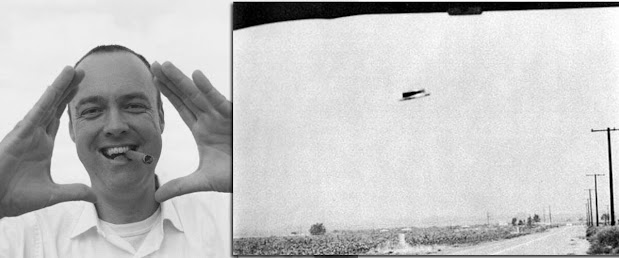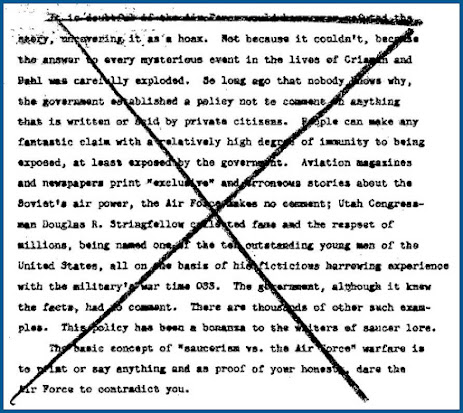Originally published at Blue Blurry Lines, May 27, 2018
 |
| Captain William L. Davidson (L) and Lieutenant Frank M. Brown (R). |
Remembering Captain William Davidson and Lieutenant Frank Brown, and how the Maury Island hoax of 1947 resulted in the first casualties related to ufology.
 |
The Galveston Daily News Aug. 3, 1947 |
Excerpts from The Report On Unidentified Flying Objects by Edward J. Ruppelt, 1956.
Ruppelt changed the names of Kenneth Arnold, Ray Palmer (publisher of Amazing Stories and Fate magazine, and also the "harbor patrolmen," Harold Dahl and Fred Crisman. For clarity, I've inserted the true names in parentheses.
For the Air Force the story started on July 31, 1947, when Lieutenant Frank Brown, an intelligence agent at Hamilton AFB, California, received a long-distance phone call. The caller was (Kenneth Arnold), who had met Brown when Brown investigated an earlier UFO sighting, and he had a hot lead on another UFO incident. He had just talked to two Tacoma Harbor patrolmen. One of them had seen six UFO's hover over his patrol boat and spew out chunks of odd metal. (Arnold) had some of the pieces of the metal.
The story sounded good to Lieutenant Brown, so he reported it to his chief. His chief OK'd a trip and within an hour Lieutenant Brown and Captain Davidson were flying to Tacoma in an Air Force B-25. When they arrived they met (Arnold) and an airline pilot friend of his in (Arnold's) hotel room. After the usual round of introductions (Arnold) told Brown and Davidson that he had received a letter from (Ray Palmer) a Chicago publisher asking him, (Arnold), to investigate this case. The publisher had paid him $200 and wanted an exclusive on the story, but things were getting too hot, (Arnold) wanted the military to take over.
(Arnold) went on to say that he had heard about the experience off Maury Island but that he wanted Brown and Davidson to hear it firsthand.
He had called the two harbor patrolmen and they were on their way to the hotel. They arrived and they told their story... two men (Harold Dahl) and (Fred Crisman)...
In June 1947, (Harold Dahl) said, his crew, his son, and the son's dog were on his patrol boat patrolling near Maury Island, an island in Puget Sound, about 3 miles from Tacoma. It was a gray day, with a solid cloud deck down at about 2,500 feet. Suddenly everyone on the boat noticed six "doughnut shaped" objects, just under the clouds, headed toward the boat. They came closer and closer, and when they were about 500 feet over the boat they stopped. One of the doughnut shaped objects seemed to be in trouble as the other five were hovering around it. They were close, and everybody got a good look. The UFO's were about 100 feet in diameter, with the "hole in the doughnut" being about 25 feet in diameter. They were a silver color and made absolutely no noise. Each object had large portholes around the edge.
As the five UFO's circled the sixth, (Dahl) recalled, one of them came in and appeared to make contact with the disabled craft. The two objects maintained contact for a few minutes, then began to separate. While this was going on, (Dahl) was taking photos. Just as they began to separate, there was a dull "thud" and the next second the UFO began to spew out sheets of very light metal from the hole in the center. As these were fluttering to the water, the UFO began to throw out a harder, rocklike material. Some of it landed on the beach of Maury Island. (Dahl) took his crew and headed toward the beach of Maury Island, but not before the boat was damaged, his son's arm had been injured, and the dog killed. As they reached the island they looked up and saw that the UFO's were leaving the area at high speed. The harbor patrolman went on to tell how he scooped up several chunks of the metal from the beach and boarded the patrol boat. He tried to use his radio to summon aid, but for some unusual reason the interference was so bad he couldn't even call the three miles to his headquarters in Tacoma. When they docked at Tacoma, (Dahl) got first aid for his son and then reported to his superior officer, Crisman, who, (Dahl) added to his story, didn't believe the tale. He didn't believe it until he went out to the island himself and saw the metal.
(Dahl's) trouble wasn't over. The next morning a mysterious visitor told (Dahl) to forget what he'd seen.
Later that same day the photos were developed. They showed the six objects, but the film was badly spotted and fogged, as if the film had been exposed to some kind of radiation.
Then (Arnold) told about his brush with mysterious callers. He said that (Dahl) was not alone as far as mysterious callers were concerned, the Tacoma newspapers had been getting calls from an anonymous tipster telling exactly what was going on in (Arnold's) hotel room. This was a very curious situation because no one except (Arnold), the airline pilot, and the two harbor patrolmen knew what was taking place. The room had even been thoroughly searched for hidden microphones.
That is the way the story stood a few hours after Lieutenant Brown and Captain Davidson arrived in Tacoma.
After asking (Dahl) and Crisman a few questions, the two intelligence agents left, reluctant even to take any of the fragments. As some writers who have since written about this incident have said, Brown and Davidson seemed to be anxious to leave and afraid to touch the fragments of the UFO, as if they knew something more about them. The two officers went to McChord AFB, near Tacoma, where their B-25 was parked, held a conference with the intelligence officer at McChord, and took off for their home base, Hamilton. When they left McChord they had a good idea as to the identity of the UFO's. Fortunately they told the McChord intelligence officer what they had determined from their interview.
In a few hours the two officers were dead. The B-25 crashed near Kelso, Washington. The crew chief and a passenger had parachuted to safety. The newspapers hinted that the airplane was sabotaged and that it was carrying highly classified material. Authorities at McChord AFB confirmed this latter point, the airplane was carrying classified material.
In a few days the newspaper publicity on the crash died down, and the Maury Island Mystery was never publicly solved.
Later reports say that the two harbor patrolmen mysteriously disappeared soon after the fatal crash.
They should have disappeared, into Puget Sound. The whole Maury Island Mystery was a hoax. The first, possibly the second-best, and the dirtiest hoax in the UFO history. One passage in the detailed official report of the Maury Island Mystery says:
Both ______ (the two harbor patrolmen) admitted that the rock fragments had nothing to do with flying saucers. The whole thing was a hoax. They had sent in the rock fragments [to a magazine publisher] as a joke. ______ One of the patrolmen wrote to ______ [the publisher] stating that the rock could have been part of a flying saucer. He had said the rock came from a flying saucer because that's what [the publisher] wanted him to say.The publisher (Ray Palmer), mentioned above, who, one of the two hoaxers said, wanted him to say that the rock fragments had come from a flying saucer, is the same one who paid (Arnold) $200 to investigate the case.
The report goes on to explain more details of the incident. Neither one of the two men could ever produce the photos. They "misplaced" them, they said. One of them, I forget which, was the mysterious informer who called the newspapers to report the conversations that were going on in the hotel room. (Dahl) mysterious visitor didn't exist. Neither of the men was a harbor patrolman, they merely owned a couple of beat-up old boats that they used to salvage floating lumber from Puget Sound. The airplane crash was one of those unfortunate things. An engine caught on fire, burned off, and just before the two pilots could get out, the wing and tail tore off, making it impossible for them to escape. The two dead officers from Hamilton AFB smelled a hoax, accounting for their short interview and hesitancy in bothering to take the "fragments." They confirmed their convictions when they talked to the intelligence officer at McChord. It had already been established, through an informer, that the fragments were what Brown and Davidson thought, slag. The classified material on the B-25 was a file of reports the two officers offered to take back to Hamilton and had nothing to do with the Maury Island Mystery, or better, the Maury Island Hoax.
(Arnold) and his airline pilot friend weren't told about the hoax for one reason. As soon as it was discovered that they had been "taken," thoroughly, and were not a party to the hoax, no one wanted to embarrass them.
The majority of the writers of saucer lore have played this sighting to the hilt, pointing out as their main premise the fact that the story must be true because the government never openly exposed or prosecuted either of the two hoaxers. This is a logical premise, but a false one. The reason for the thorough investigation of the Maury Island Hoax was that the government had thought seriously of prosecuting the men. At the last minute it was decided, after talking to the two men, that the hoax was a harmless joke that had mushroomed, and that the loss of two lives and a B-25 could not be directly blamed on the two men. The story wasn't even printed because at the time of the incident, even though in this case the press knew about it, the facts were classed as evidence. By the time the facts were released they were yesterday's news. And nothing is deader than yesterday's news.
 |
(Twin Falls) Times-News Aug. 3, 1947 |
 |
Oakland Tribune Aug. 6, 1947 |


































